Chord Crush User Guide
Version 1.0.0
Contents
Contents
Introduction Video
The following introductory video will show you the basic modes of Chord Crush.
Play Modes
Level Up
The “Level Up” mode is meant to target specific concepts and chords. It is progressive in difficulty, starting at a very basic level (only 2 basic chords to distinguish between) and moves up from there. Each level focuses on one new concept or variation. Each “World” consists of a dozen or so of these levels and has a given theme (i.e the basic chords, embellishments, or inversions).
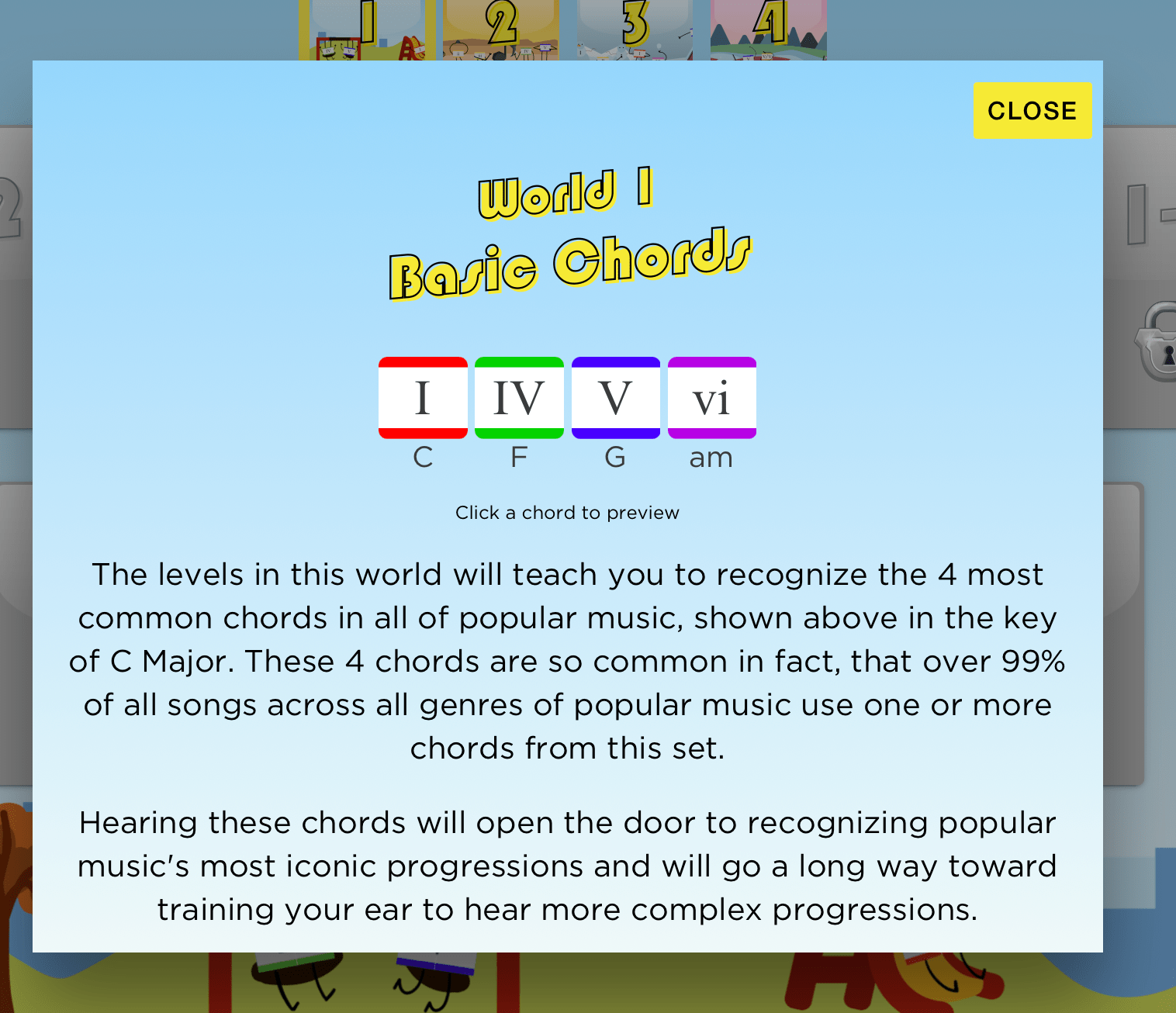
In each level you are presented with 10 puzzles to solve. Each puzzle is a chord progression with some chords missing. Your job is to identify the missing chords from the choices below. Drag the correct chords to the missing chords and you get the puzzle right. You lose a life if you get the puzzle wrong, and to complete the level you need to finish all 10 puzzles before running out of lives.
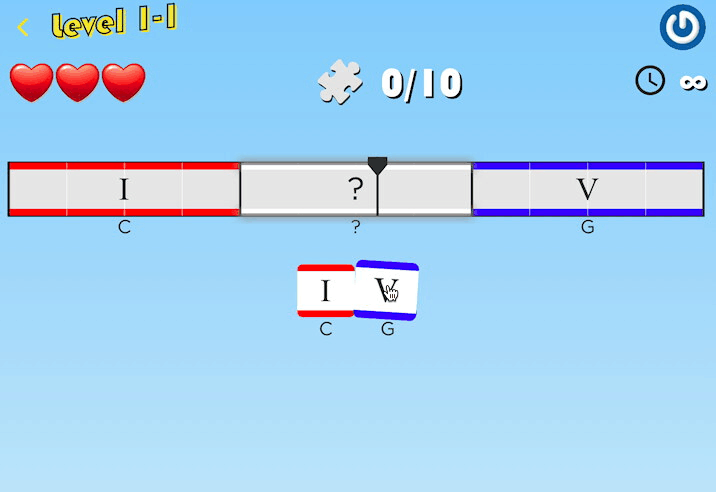
Each level can be completed multiple times at different difficulty levels. Higher difficulty levels have faster tempos, have more chords to identify, start to introduce key changes between puzzles, and give you fewer lives.
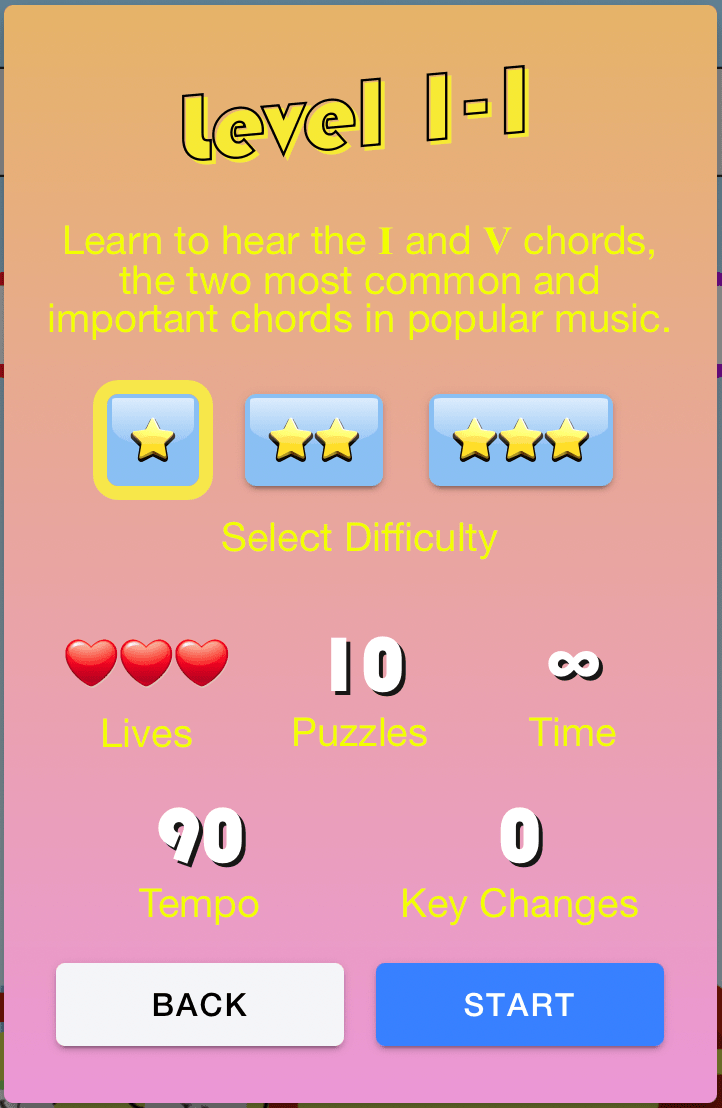
To unlock a level you must complete previous levels on the “easy” difficulty setting. When you complete all the levels on a given world at the 2 star “medium” difficulty you unlock a bonus level that tests you using the real audio of a song.
Train Mode
“Train” is a general training mode that presents you with puzzles in a variety of themes. Rather than being level based, you are assigned a rating that increases or decreases when you get a puzzle right or wrong. You will be given puzzles to solve that the system considers appropriate for your current rating so as you get better and your rating improves you’ll train on more challenging puzzles. Tracking your rating over time is a good way to measure long term improvement. You can learn more about the ELO based rating system below. Train is good mode for daily practice because it mixes the themes up and you don’t know ahead of time what concept you will be tested on so it simulates the real world a bit better than the focused training in “Level Up”. Train mode, also uses chord progressions from real songs. You can see from what section of the song the puzzle was drawn from by clicking on the Song Play icon that pops up when the solution of a puzzle is shown. You can choose to hear the original recording or the Midi rendition with melody.
Audio Source Selection
Train mode allows you to select an audio source. By default the chord progressions use a basic piano sound to simplify and isolate the sound of the chords within the progression without distraction. You can change the arrangement or “Band” to include guitar/full band with drums/electronic to mix things up in Settings. For an even greater challenge you can change the audio mode to “YouTube” to hear the real audio from a YouTube Music Video with missing chords. This is the most realistic but also the most challenging.
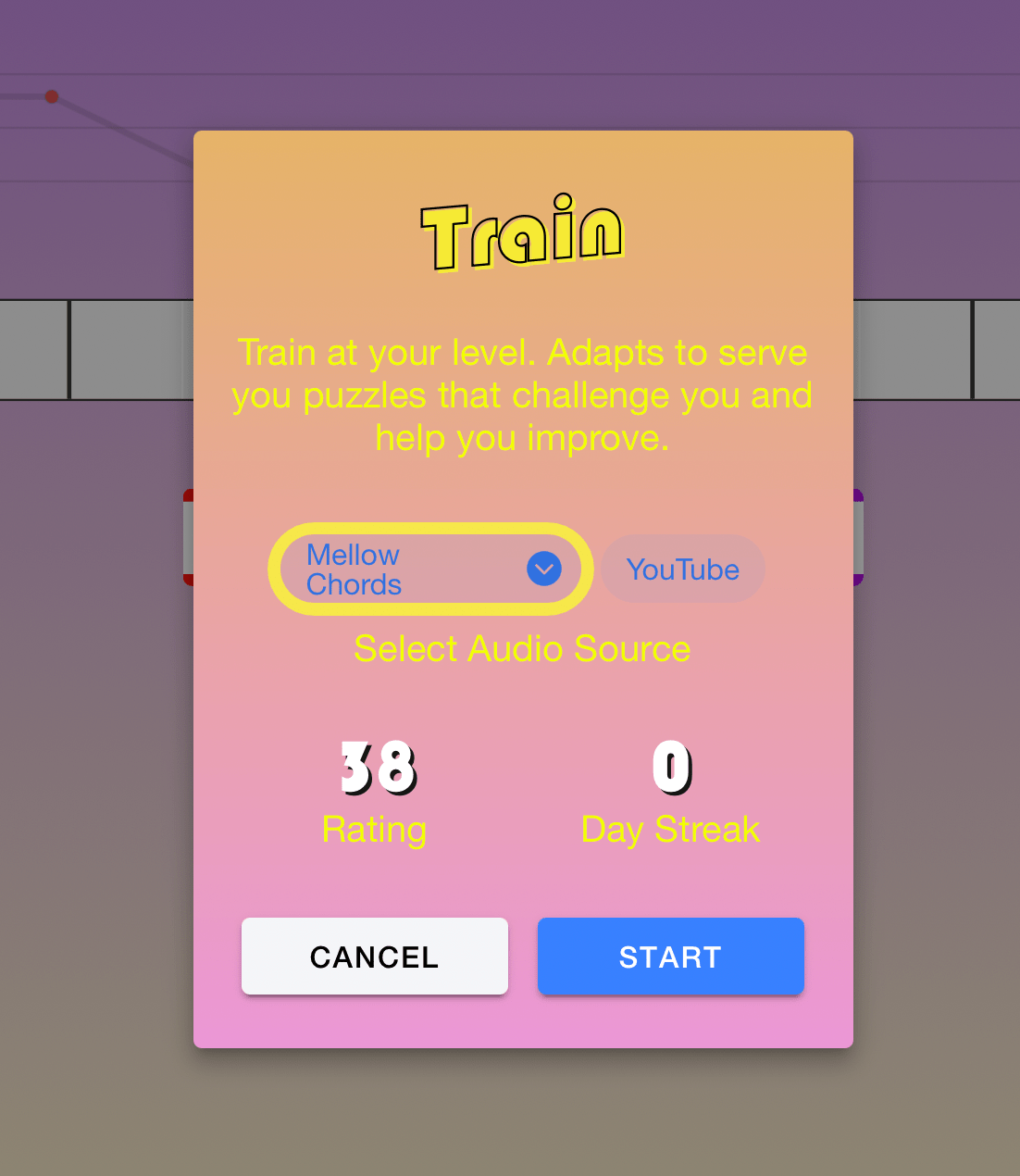
Other settings:
The settings menu lets you choose the instrumental arrangement, whether you hear the melody, among other things. Detailed information about the settings can be found below.
Rush! Mode
Rush is a game-like mode that challenges you to solve as many puzzles as you can in a period of time (3 or 5 minutes). The puzzles start very easy and increase in difficulty. While this is meant to be a fun “game”, it’s also an important of improving your ear. Because of the time aspect, Rush trains instant recognition, which is the ultimate goal of ear training. You want to be able to hear a chord and immediately know what it is without having to think or work anything out.
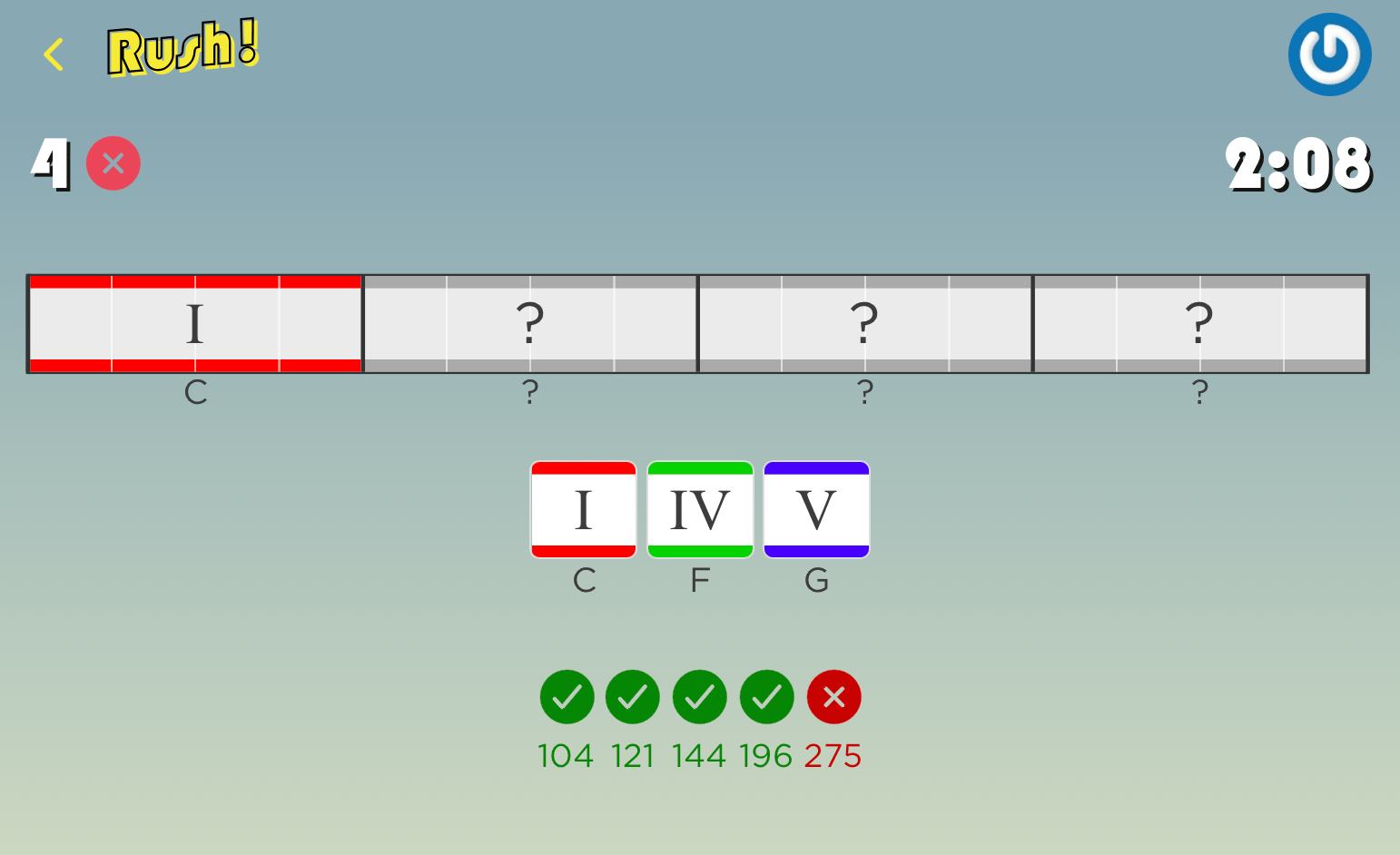
Customize
These modes require Chord Crush Premium and allows for more customized practice sets that target problem areas.
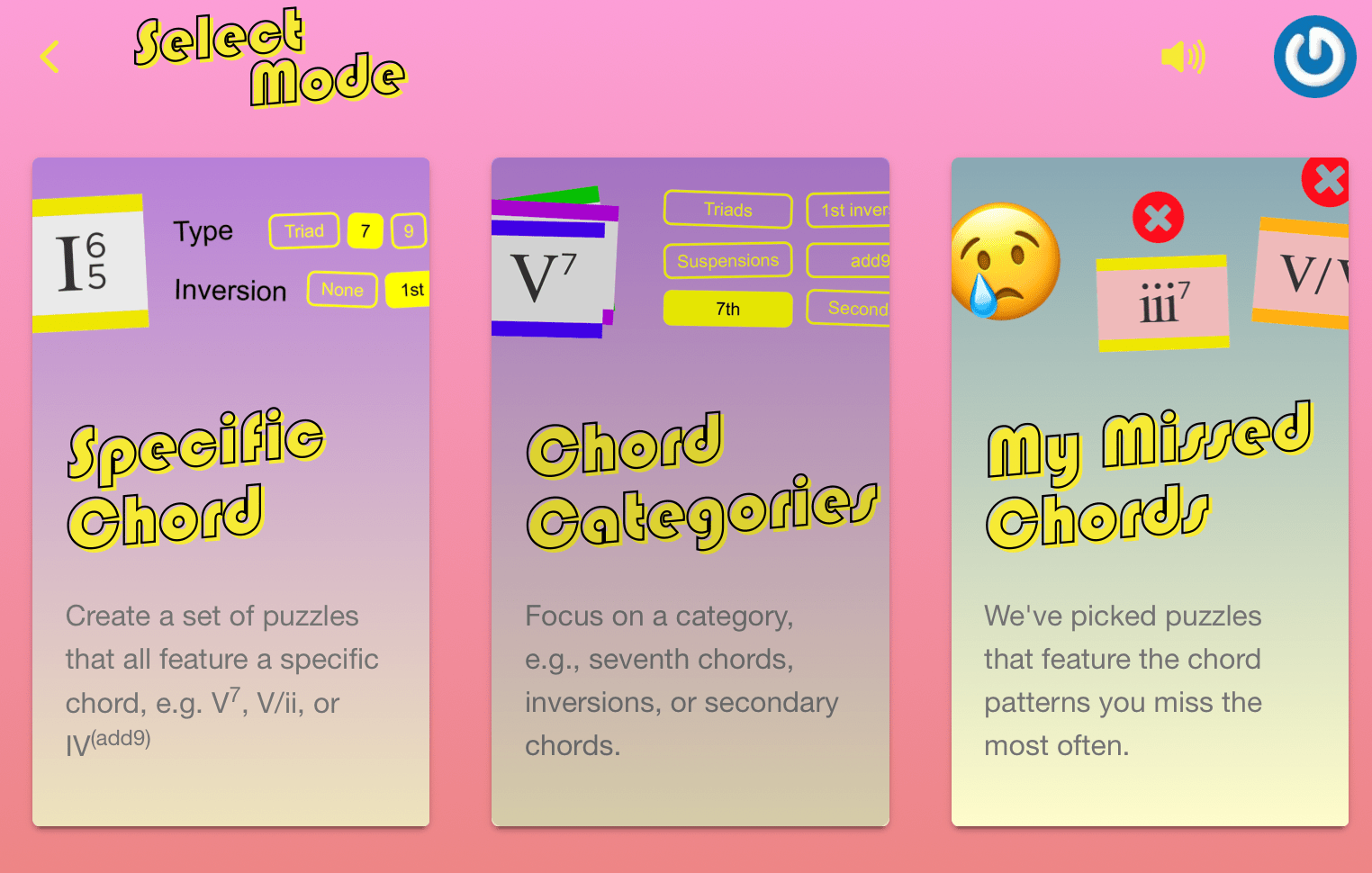
Specific Chord
Allows you to train on sets of chords that are guaranteed to contain a specific chord you are having trouble with.
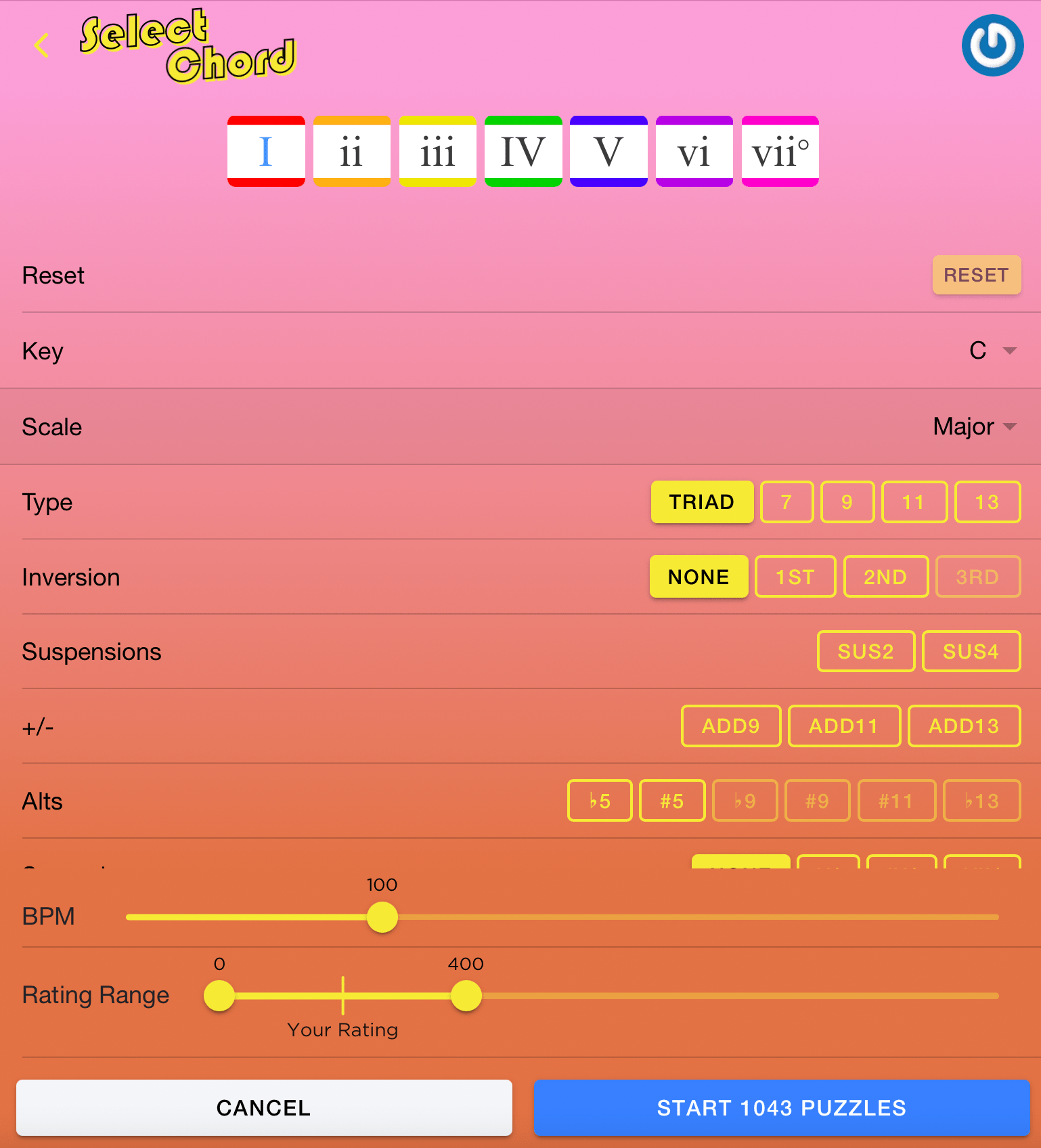
Chord Categories
Allows you to specify chord properties. For example if you need help with Inversions or 7th chords you can select these chords types (along with a difficulty range) and focus on that area.
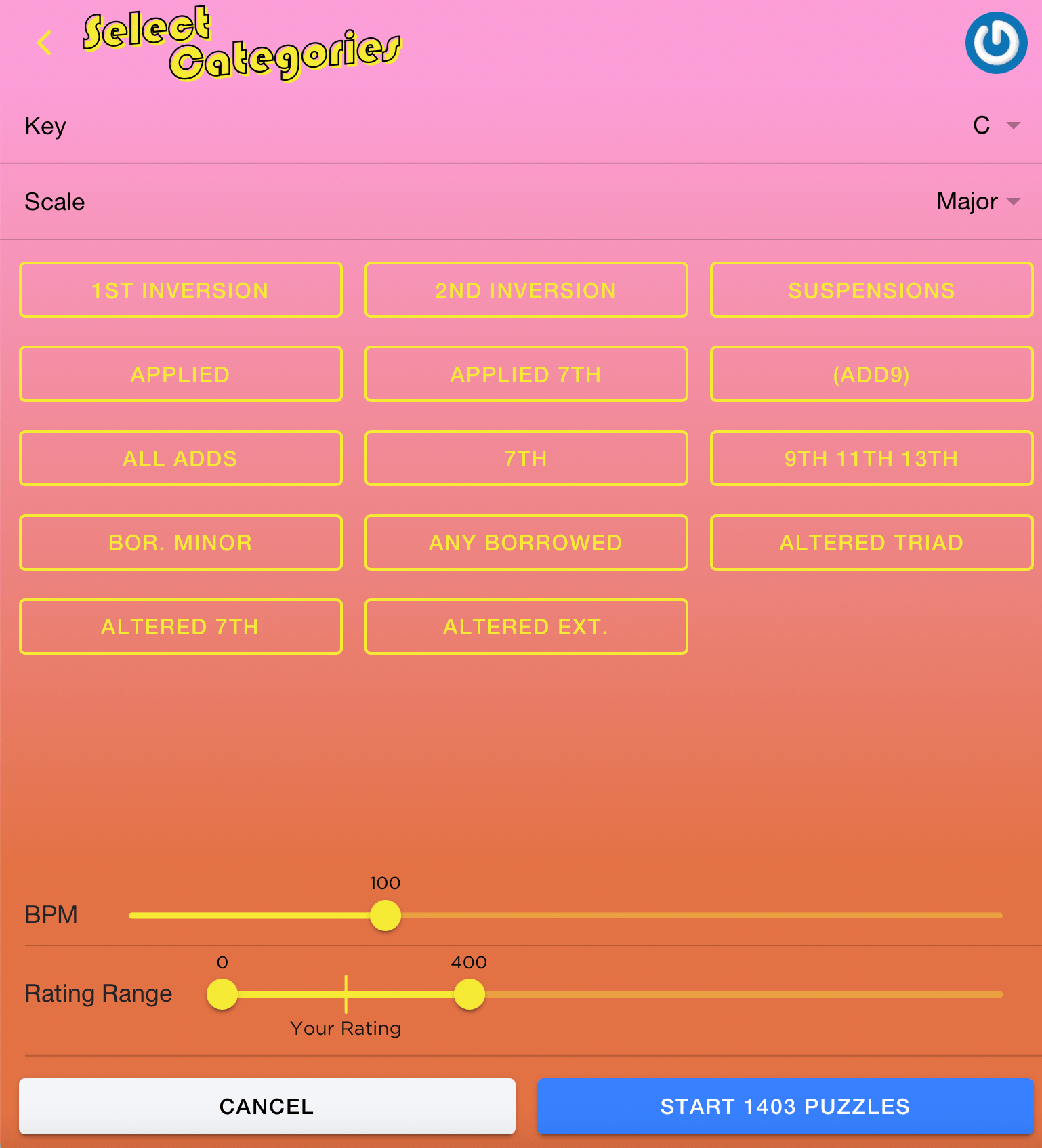
Missed Chords
Chord Crush also tracks which chords you have missed and can create custom sets tailored to the areas you need the most help in.
Settings
The following settings are available to customize and configure your play experience:
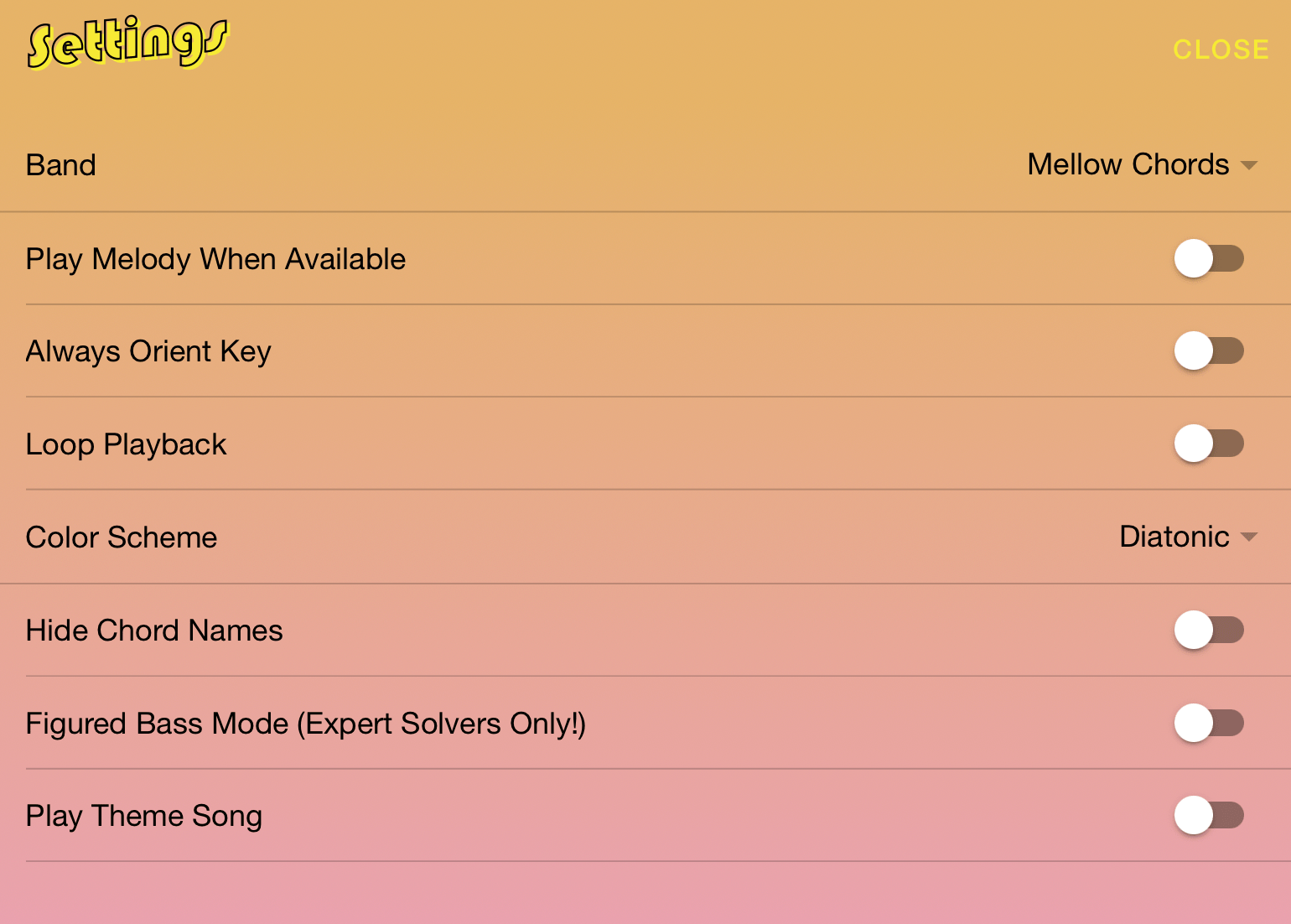
Settings can be accessed at the bottom of main play screen as well as near the bottom of main Chord Crush title/mode select screen.
- Play Melody when available: Many of the songs in Train mode have information about the melody in them. Turn on the melody for an extra challenge (melody is muted by default to make the chords easier to hear).
- Band: This setting changes the instruments used by the midi audio playback engine. By default a simple piano is used to play the chords, but this can be changed to other sounds from single instruments like guitar to full arrangements like “Rock band” with drums and multiple instruments.
- Always Orient Key: The key orienter is a short chord progression designed to help you center yourself around the new key. It is especially important to hear it after a key change and it will play automatically whenever this occurs. To hear it all the time before every puzzle this option is available.
- Loop Playback: Choose this option to continuously play the puzzle over and over again after it completes rather than hitting space bar or clicking play.
- Color Scheme: The color scheme is what the system uses to color the chords. This is only relevant at more advanced levels when you are analyzing progressions in other modes (i.e minor/mixolydian) when the coloring scheme becomes a question (what color should the I chord be). For more detailed information about chord coloring schemes refer to the Hookpad manual. https://www.hooktheory.com/support/hookpad#settings-colors
- Diatonic centric: For each scale, colors are cycled so that both the intervals between note colors and the quality of chord colors is preserved.
- Major centric: Colors are based on how each scale degree and chord root relates to the major scale.
- Scale centric: Colors are the same for each scale. Scale degree 1 is always red. Scale degree 2 is always orange, etc.
- Hide Chord Names: Turns off the text labeling the chords so you just see the color.
- Figured Bass Mode: Switches to a classical music analysis advanced figured bass mode.
- Play Theme Song: Toggles whether you hear the Chord Crush theme music.
FAQ and General Tips for improvement
Why should I want a better ear?
The ultimate goal is to be able to listen to something and know immediately what is being played without having the music for it in front of you. The ability to hear what is going on in music will unlock a huge variety of patterns and ideas that can be incorporated into your own work. Any time you listen to music becomes an opportunity for inspiration. You also benefit by gaining the ability to play by ear or better improvise on the fly.
Why focus only on chords (and not intervals or melody)?
Melody is important, and we will expand to focus in other areas over time, but chord-focused practice is a gap that, in our opinion, hasn't been done well yet. Interval identification -- that is, being able to identify the spacing between two notes (i.e that a C to an F is an “ascending perfect 4th”) is often where classically trained people start, but it's easy to get bogged down in that. It's also often needlessly treated as a prerequisite. The reality is that being able to identify chords is a different skill and of great practical value on its own. Formal interval training will, of course, help (it's a tool and a means to an end) but can be done separately/in parallel if desired..
Why numbers/Roman numerals?
Chord Crush develops your Relative Pitch. With Relative Pitch, the goal is not to be able to identify the precise notes or frequencies being played (this is called Absolute or Perfect pitch). Instead, the focus is on hearing chords relative to the key or home base. Perfect pitch is difficult to develop (unless you are an infant) and is less useful. Relative pitch lets you translate what you hear into any key later and reinforces on musical function. If you aren't familiar with relative music notation and the idea of thinking 'in a key' is foreign to you, we recommend reading the first (free) chapter of our music theory for songwriting book. It introduces the idea of Roman Numerals and Scale Degrees and discusses why it is so important for understanding music.
How does Chord Crush work?
You will be presented with a chord progression pulled from a real song from our Theorytab Database with some of the chords missing. Drag a chord from the available options below to fill in the missing ones!
What if I am a total beginner?
That’s ok! The puzzles at the lower rating levels are meant to be solvable by beginners. If you think the puzzles you are getting are too difficult, getting a few in a row wrong will cause the system to naturally adjust what type of puzzle you get. At the lower levels, you can click on the chords to hear how they sound for help. As your rating improves we gradually remove the ability to "preview" chord sounds until you can identify chords just by hearing them.
How hard do the puzzles get?
Very hard. The Hooktheory song database contains some very complex progressions in exotic modes, with tricky borrowed chords, and jazzy embellishments. Even if you have perfect pitch, you will be challenged!
How should I start?
If you are a new beignner, the Level Up game starts at the most basic (just two chords, I and V) and slowly builds from there. Each of the levels has several star levels (easy, medium, hard). We don't recommend completing every level on hard before moving on to the next. The harder levels increase tempo, add key changes, and have longer more complex progressions which really tests mastery of the subject. At a minimum we recommend going through the 1st “World” on easy (1 star) so you have exposure to the basic four chords. At that point, you can explore however you see fit, for example, by repeating the levels you’ve already completed but on harder difficulty levels, trying to learn new sounds/chords in “World” 2, or starting a practice routine with drills in the Train mode (discussed in more detail below).
How should I practice?
Once you've gone through some of the topic-focused “Levels”, the best way to get better is through repetition and practice. You need to imprint these patterns into your brain by practicing listening to the sounds over and over again, consistently over a period of time. The Train mode is designed for this type of practice. The system starts giving you puzzles, and as you answer them, it starts to learn your ability level and will dynamically present puzzles at your ability. We recommend doing some training exercises every day. Keep in mind, our brains can only absorb so many patterns at once so it’s better to do consistent daily practice rather than cramming in one long session all at once. It's also important to focus on what you got wrong. When you miss a puzzle, don’t just go to the next one. Try to understand why you missed it and what was confusing. Listen to the progression a few times to memorize the sound of the chord you missed. This is where the learning happens.
What does my rating mean?
Chord Crush tracks your ability level through a numbered rating system and tries to give you puzzles near that rating so you have a good chance of getting them correct. The rating is an ELO rating, similar to what is used in, for example, Chess to rate/rank player strength. You can read more about it on wikipedia https://en.wikipedia.org/wiki/Elo_rating_system (there’s math). Essentially you are playing a game against each puzzle and your rating will increase or decrease based on whether you solve it correctly or not. If you solve a puzzle correctly that the system considers difficult relative to your level, your rating will increase more than if you solve a puzzle that the system thinks is easy. The rating of the puzzle will also increase or decrease as well so over time your rating should both reflect your true current ability as well as improve the accuracy of the puzzle ratings themselves. You can ignore this rating entirely and just know that, in Train mode, the system is going to give you puzzles that are appropriate for your ability, or you can use it as a metric to track your improvement. If you do pay attention to your rating, we recommend ignoring short term fluctuations up or down. This noise is expected, it’s the long term level that is potentially worth watching.
What are the other modes for?
Variety is important for improving. If you just mindlessly do a few puzzles every day, you will improve but you'll likely plateau at some point. The trick to keep progressing is to mix things up and drill these patterns into your brain in different ways so that it eventually sticks. The Custom modes let you target specific problem areas and can be used if you want to focus on a particular chord you know you are having trouble with. The Rush game is also a different way of practicing. It forces you to do some easy puzzles quickly and is good for targeting the kind of instant recognition you are hopefully working towards. We track the highest number of puzzles you’ve been able to get right in Rush, and it’s meant to be a fun additional score/metric to try to watch and improve upon.
Can I use other sounds besides piano?
Yes! And in fact this is a great way to practice hearing the chords in different scenarios to test that you really can hear the chord and are not just memorizing the particular way the voicings sound on a particular instrument. After all, your goal is to hear what is going on in real music, not get a high Chord Crush rating. As soon as you are able, we recommend switching the instruments up from puzzle to puzzle (this is in Settings). It's definitely harder but it's a much better approximation of what real music sounds like.
Speaking of real music, are there puzzles that will let me identify chords from real audio recordings?
Yes, this is a setting in Train (change the audio source to YouTube from Midi). When you are first getting started and want to learn a new chord. It's probably best/more optimal to keep the key the same and use a simple instrument like piano with no distractions. When you get more comfortable with the new sound you can start changing the instruments, the key, and tempo to make it harder/mix things up. Finally the real audio puzzles are the ultimate test.
Why does the same chord sound different?
Chords can be played in many different ways and still be the same chord. C major chords are made up of C, E and G but there is conserable freedom. The lowest note, the bass, in a C major chord must always be C, but the other notes that make up a chord can be in different octaves and in all sorts of different combinations and spacings. These are called voicings. Other voicings are equally valid and you need to be able to identify a chord regardless of how it is played or on what instrument created it. Chord Crush uses natural voicings that will change with the key. This definitely makes things more challenging, but these voicings all function the same way so training your ear to hear them all as the same chord is the right approach musically.
I'm trying to hear individual notes to identify the chord but it's really hard!
It can be tempting to try to pick out all the individual notes, figuring out which ones are present or not and potentially identifying what intervals they make with each other to zero in on the correct chord, but this is usually not the best strategy. As noted above, chords can be voiced differently so the notes that make them up will often be in a different order. Also, trying to pick out individual notes is time consuming. If you’re stuck, focusing on individual notes can be a good strategy (it's another tool you can use) but ultimately you are looking for instant recognition. V chords sound a certain way relative to the home base and have a particular function and sound. Listen for that sound. Try to hear the chord as its own entity and only dive into its constituent parts as a backup.
What else can I do to make this easier?
As mentioned above, the function of the chord and the role it plays in the progression is a huge clue that you can use to identify it. The V → I transition, for example, is one of the most recognizable in music. The upshot is knowing more about how chords function will absolutely make it easier to recognize them by ear.
Do you have any recommendations for an approachable take on understanding chord function? Why yes, I'm glad you asked. Our Music theory for songwriting series is aimed at making these concepts as approachable as possible. The books don't require you to read conventional sheet music, and they use popular music for all the examples. A lot of classical music theory treatments spend a lot of time on notation, key signatures, and other technical details as a prerequisite to learning higher level concepts. Our approach has a very different emphasis and an immediate focus on chord function.
Does Chord Crush work on mobile devices?
Yes. It was designed for phones/tablets. It also works great with a mouse and large screen.
What is the Key Orienter about (the short musical diddy that plays at the beginning of some puzzles)?
Because the puzzles are in Roman Numeral/Relative notation, the answers only make sense if you know what key you are in. For example, consider the case of a G major chord followed by a C major chord. If we don't know the key and have no other context, it's not possible to say what we are hearing. If we were in the key of C, these chords would be V -> I and we’d hear the progression returning to the home base of the key (C major in this case). But if we are in the key of G then the same two chords would be heard as starting on the home base chord (G major) and expanding to a IV chord (C major). This is why the relative system is so important in the first place. Key and function are everything. Being able to hear the home base chord (I) is very important because essentially the entire point is to learn to hear and number the chords relative to that chord. The Key Orienter is essentially playing a short I IV V I progression with a strong resolution to the I chord at the end to help orient your ear to the key. It will automatically play if a new puzzle has a different key from the previous one. In the beginning (at lower puzzle ratings), the exercises will stay in the same key from puzzle to puzzle, and it's probably better to keep it that way for a while since reorienting your ear to a new home base can be challenging.
Is there an iOS or Android app?
Not yet. For now, just the web app at chordcrush.hooktheory.com. If you purchase a subscription for Chord Crush, it will work for any future iOS / Android app.
Does Chord Crush cost money?
The basic version is free but has limited functionality: you can do 5 puzzles per day and 1 Rush game! If you'd like to remove these limits Chord Crush is $50 per year billed annually.
Troubleshooting Activation
It says I need to purchase but I already did
If you already purchased Chord Crush but are getting messages when trying to use certain features that you need to purchase, follow steps 1-3 below.
Step 1: Make sure you activated your purchase
- Activation is the process of linking your Chord Crush purchase to your Hooktheory account.
- If you were signed into www.hooktheory.com when you purchased Chord Crush, this happens automatically.
- If you were not signed in to www.hooktheory.com when you made the purchase, you will have received an email containing an activation link. Click that activation link and follow the instructions to link the purchase the your account (requires sign in to Hooktheory or account creation if you don’t already have an account.)
- If you can’t find this email (did you look in your spam folder?), you can contact support via email (support at hooktheory dot com), and we can activate it for you
- Once your purchase is activated, you will see an orange “Open Chord Crush” button in the top of the Hooktheory website. If you see the orange button proceed to the next step.
Step 2: Sign in to the Chord Crush app
Check the upper right corner of the Chord Crush app to see if you are signed in. If not, sign in with the same account you used to purchase Chord Crush. (It is possible to be signed in to www.hooktheory.com but not the Chord Crush app.)Step 3: Troubleshooting
If you've followed these steps 1 and 2 and still don’t have access, there are a couple causes.- If it has been more than a year since you subscripted, it’s possible your credit card is no longer valid (or is being rejected) and your subscription was put on hold. Go to www.hooktheory.com/account to see whether you purchases are linked and active.
- It’s possible the purchase got linked to a different account than the one you are using. Do you have a second Hooktheory account? If you accidentally linked the purchase to the incorrect account you can contact support about it.
- If none of the above work, contact support at hooktheory dot com and we will locate your purchase.